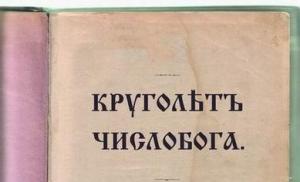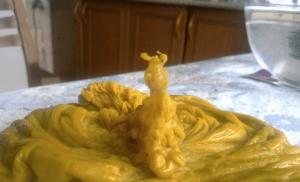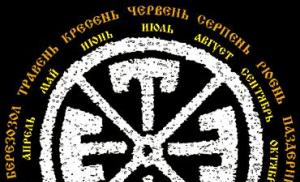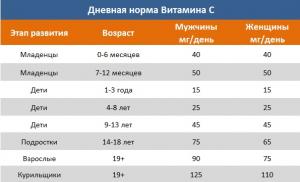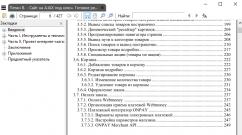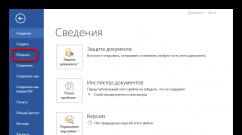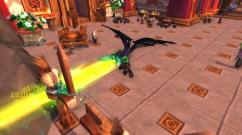The firm's economy is the proportion of the cost of the formula. The share of material costs in the cost of production
The specific gravity and its calculation is one of the most common indicators. Its calculation is used in statistics, organization economics, analysis of financial economic activity, economic analysis, sociology and many other disciplines. In addition, the indicator specific gravity is used when writing analytical chapters of coursework and diploma theses.
Initially, specific gravity is one of the methods of statistical analysis, or rather, even one of the varieties of relative values.
The relative size of the structure is the specific gravity. Sometimes the specific gravity is called the proportion of the phenomenon, i.e. it is the proportion of an element in the total volume of the population. The calculation of the proportion of an element or specific gravity (as you like) is carried out most often as a percentage.
//
The formula for calculating the specific gravity
The formula itself can be presented in different interpretations, but its meaning is the same and the principle of calculation is the same.
Two important rules:
- The structure of the phenomenon should always be equal to 100%, neither more nor less, if the addition of fractions of 100 did not work out, then carry out additional rounding, and the calculations themselves are best done with hundredths.
- It is not so important the structure of what you are calculating - the structure of assets, the share of income or expenses, the share of personnel by age, sex, length of service, education, the share of products, the structure of the population, the share of costs in the composition of the cost - the meaning of the calculation will be the same, divide the part by the total, multiply by 100 and get the specific gravity. Do not be afraid of different words in the text of the problem, the principle of calculation is always the same.
An example of calculating the specific gravity
We check the sum of the shares ∑d = 15.56 + 32.22 + 45.56 + 6.67 = 100.01%, with this calculation there is a deviation from 100%, so 0.01% must be removed. Remove it from the group 50 and older, the adjusted share of this group will be 6.66%.
We enter the received data into the final calculation table

All direct tasks for determining the specific gravity have this calculation principle.
Complex structure - there are situations when a complex structure is presented in the initial data, several groupings are included in the phenomenon. The object is divided into groups, and each group, in turn, is not yet subgroups.
In such a situation, there are two ways of calculating:
- either we calculate all groups and subgroups according to a simple scheme, we divide each number by the total given;
- either the groups are counted from the general given, and the subgroups from the size of this given group.
We use a simple structure calculation. We divide each group and subgroup by the total population. In this way of calculation, we find out the share of each group and subgroup in the total population. When checking, only the groups will need to be added - in this example, the urban and rural population in the total number, otherwise if you add up all the data, the sum of the shares will be 200%, a double count will appear.
We enter the calculation data into the table
Let's calculate the share of each group in the total population and the share of each subgroup in the group. The share of urban and rural population in the total population will remain the same as in the calculation above 65.33% and 34.67%.
But the calculation of the shares of men and women will change. Now we will need to calculate the proportion of men and women in relation to the urban population or the rural population.
That's all. Nothing complicated or difficult.
Good luck to all in the calculations!
If something in the article is not clear, ask questions in the comments.
And if suddenly someone finds it difficult to solve problems, contact the group for help!
Catalog: the proportion of variable costs in the price formula
- The need to take into account other income and expenses in the marginal analysis
Ufact the minimum price Ct1p is determined at which the product can be sold without loss C min UPR V fact n 1 ... However, when using all these formulas and functional dependencies, the question remains aside what specific costs of the enterprise should be included in ... To determine the profitability threshold, we use the formula 1 The share of variable costs in revenue in this example is 60% 600 1000 x 100 - Will there be enough money to bring the company's plans to life?
Stocks of basic raw materials at the end of the period thousand rubles variable costs for the period from table 1 x line 11 line 1 528 562.37 615.10 659.03 ... the share of variable costs in revenue Example According to the opening balance sheet, the cost of inventory of goods in ... X 19 days 31 days rubles 640 thousand rubles X 90.8% and the volume of production - ... The amount of the company's accounts payable to suppliers at the end of the period can be determined by the following formula - On the scope of the WACC indicator as a financial calculation instrument
The above formulas contain a paradox arising from the fact that dividends reduce the value of the company and the wealth of shareholders ... In the Russian Federation, only two variables - revenue growth and the degree of state participation in equity capital - show a correlation with ... Amount RUB mln Share Price of the source of capital % Cost of capital% Gr 5 gr Z gr 4 - Analytical capabilities of consolidated reporting to characterize financial stability
And Barilenko, the starting point in the calculation of transfer prices can be the following formula: the transfer price should be equal to the sum of the unit variable costs of transfer products and the specific marginal ... groups that can be determined both mathematically and specific weights with analytical coefficients are determined by expert advice and adjusted taking into account the industry specifics of the cycle phase - The effect of operating leverage in the margin analysis system
There are other more complex modifications of the formula for calculating the effect of operating leverage that differ from the one presented by us However, despite the differences in algorithms ... Despite these objective constraints, if necessary, each enterprise has enough opportunities to reduce the amount and share of fixed operating costs. significant reduction in overhead costs ... When managing variable costs, the main guideline should be to ensure their constant savings, since between the sum of these ... The mechanism of applying operating leverage depends on what factors affect the change in sales revenue in the planning period compared to the baseline dynamics prices or the dynamics of the real volume of sales or both factors together As a rule, in practice, revenue - Financial security of the company: analytical aspect
A change in sales revenue leads to an even stronger change in profit, which is explained by the disproportionate impact of fixed and variable costs on the financial result when the volume of production and sales changes, the higher the share of fixed ... fixed and variable costs for the financial result when the volume of production and sales changes, the higher the share of fixed costs in the cost of production, the stronger the impact of operating leverage With an increase in sales, the share of fixed costs ... is considered as a positive factor for the enterprise Ai ... Ai is the proportion of the Ki indicator - the value of the indicator whose increase is considered as a positive factor for the enterprise ... The decline in oil prices hit the company about especially strong Weak points of the business include insufficient supply - Improving the efficiency of managing production costs through process improvement
After analyzing the statistical data presented in the table, it should be noted that the largest share of material costs in the total cost of production and sale of products of 72.8% is observed ... price discount In addition, supply-related fixed costs, such as handling costs, transportation costs ... In addition, supply-related fixed costs, such as handling costs, transportation costs, freight insurance costs in transit, etc. are reduced per unit material resources at ... The above analytical relationship 1 describes the hyperbolic relationship between the production costs associated with the provision of the enterprise with material resources and the size of the batch of their supply and also takes into account the separation of these costs for variable and constant components Assessing this dependence, any enterprise seeks to increase the size of the delivery batch ... RP N n - k N C1 m 3 - Analysis of the structure of the monetary capital of an economic entity: problems of formation and ways of optimization (on the example of JSC Uralkhimmash)
An increase in cost due to an increase in variable costs forms a minimum gross profit with a decreasing trend The latter is fully covered by fixed costs of commercial ... the company's monetary capital is borrowed. Analyzing long-term liabilities, we see that the plant does not attract long-term ... This means that the price of its own functioning capital cannot cover the borrowing costs of which it is unprofitable every year since this causes a decrease in the profitability of its own ... Since the weighted average cost of capital shows the price paid for attracting various sources of financing, therefore, the lower this price, the better ... According to the formula for calculating the market value of a business, the value of the company will be maximum when increasing net profit before payment - Key Aspects of Organizational Profit Management
K i- the price of the i-ro source of funds d i- the share of the i-th source of funds in their total amount n is the number of sources of funds ... ... A decrease in the profitability of sales in terms of net profit with an increase in the profitability of core activities indicates an excess of other expenses of the organization over other income. Note the low values of the profitability indicators of fixed assets and own ... its full cost net of value added tax VAT and excise taxes ... АVС - variable costs for the product VС - variable costs for the volume of output Profit planning does not end - The main tools for managing the financial result and current assets of the company
Its upper limit is determined by the selling price and the lower one is determined by variable costs Since marginal income is influenced by many factors, it is impossible to find a single solution, some radical ... Ageeva Electronics about the nuances of fixed costs In our company, to manage fixed costs, operating budgets with established limits are used ... VI is the lowest - there is no competitive advantage in the market; a large number of similar products are presented at a lower price or with better characteristics. Solution options based on the index of marginal income and competitive rating ... And for recalculation, you can use this formula. sales 30 days x x Limit ... Too large share of receivables in the structure of current assets leads to a decrease in the financial stability of the company We - Analysis of the financial condition of the enterprise and internal mechanisms of its recovery
In these years, Russia in these years was provided by almost 70% of the increase in prices for exported raw materials and the hidden inflationary component.At the same time, in highly developed ... America 3% in-house R&D in sales volume Russia has not lagged behind the given indicator ... It is possible to ensure the generation of its own financial resources through the implementation of the following financial recovery measures; optimization of pricing policy; reduction of fixed and variable costs; The simplest model of sustainable economic growth of an enterprise can be represented in the form of the formula ΔОР PP KPP A KOA OR SK where ΔОР is the possible rate of increase in volume - Topical issues and modern experience in analyzing the financial condition of organizations - part 4
They represent the technological level of production; the risk of the supply infrastructure; changes in supplier prices; disruption of supplies, etc.; banking risks where accounts are opened; business reputation consisting of ... The inflow in 2014 amounted to 530,645 thousand rubles, which is 63,375 thousand rubles more than in 2013. in the total volume of all cash receipts amounted to 72.42% in 2013 ... Total assets 26 Depending on the actual values for each coefficient, we will determine the value of the variable. the return on equity indicator should be focused on the level of the bank deposit interest and is determined by the following formula R n c ad 1 α np 34 where R n k is the standard value ... S KR UR
1) The largest specific weight belongs to the item of labor costs (40.6% and 41.4% in 1998 and 1999). Moreover, in 1999 labor costs increased by 9.3% due to the increase in salaries of RUS employees.
2) The second place in terms of specific weight is occupied by expenses on social taxes (15.4% and 15.8% in 1998-1999).
3) The third place in 1999 in terms of specific weight is taken by the article - materials, fuel, spare parts. parts. Moreover, in 1999, expenses under this item increased by 53.7% in relation to 1998. The reason is the increase in prices for fuels and lubricants and materials.
It should also be noted that the cost of taxes increased by 30.3%. The reason is the increase in tax rates.
For the rest of the cost items, cost savings are observed.
Savings under the item "Other expenses" amounted to 19%
Energy saving 16%
Depreciation 12%
In general, the costs of the main activity in 1999 increased by 7.2%. The main impact on the increase in costs was provided by cost items:
Materials, fuel, app. parts (5.2%);
Labor costs (3.7%);
Deduction for social taxes (1.64%).
Based on the data obtained, we will build a graph of the cost structure. Rice
The calculation and analysis of the cost structure will be performed using the data in Table 20. Calculation of the cost of services by cost item makes it possible to assess the impact of each item on the cost of a unit of communication services. A unit of communication services costs 100 rubles. income.
Analysis of the prime cost by cost item shows that the largest share in the prime cost of a communication service unit is occupied by:
The wage fund (44.6 rubles / 100 rubles) and there is a decrease in the cost of this cost item by 3.3 rubles
Deductions for social tax 17.1 rubles / 100 rub. The cost price decrease in 1999 was 1.1 rubles.
Materials, fuel, app. parts (14.8 rubles / 100 rubles). The increase in the cost of this item was 3.3 rubles.
Depreciation (9.8 rubles / 100 rub.). A decrease is observed due to the write-off of fixed assets.
Other expenses (9.3 rubles / 100 rub.) Mainly for heat supply from RUPS
Overhaul (7.9 rubles / 100 rubles). moreover, under this item, there is a decrease in the cost of 1.6 rubles.
Assessment of the impact of cost items on changes in the cost of a unit of communication services shows that these are material costs and taxes.
Table 20 - Calculation and cost structure
|
Cost item name |
Cost price, RUB / 100 RUB D. |
Specific gravity,% |
Change in cost |
|||
|
Wage fund | ||||||
|
Contributions to S.N. | ||||||
|
Depreciation | ||||||
|
Materials, fuel, app. parts | ||||||
|
Electricity | ||||||
|
Cap. repair | ||||||
|
Joint suspension | ||||||
|
other expenses | ||||||
Let's analyze the costs of communication sub-sectors, which allows us to assess the dynamics of the costs of this sub-sector by cost item, to assess the structure and impact of each cost item on the total costs of the sub-sector.
The analysis will be performed using tables.
1) Long-distance telephone communication (table No. 21)
The largest share in the structure of expenses of the sub-industry is occupied by the following items of costs:
Wages fund (45.4%);
Social tax contributions (17.4%);
Materials, fuel, app. parts (12.3%);
Depreciation (8.3%);
Other expenses (7.6%).
Table 21 - Dynamics of costs for MTS
|
Name of cost items |
Costs, thousand rubles |
Specific gravity,% |
Impact on decline |
|||
|
Wage fund | ||||||
|
Deductions for s.n. | ||||||
|
Depreciation | ||||||
|
Materials, fuel, spare parts | ||||||
|
Electricity | ||||||
|
Cap. repair | ||||||
|
Joint suspension | ||||||
When analyzing the share of costs, indicators of both the total share of costs in production and the share of individual costs (for example, material or their components - raw materials, energy) are used. The formula for calculating the share of costs in production can be represented as follows: costs / prime cost * 100%.
For example, the cost of production at an enterprise consists of the cost of raw materials (150 thousand rubles), wages of employees (100 thousand rubles), rent (50 thousand rubles) and energy costs (20 thousand rubles). Thus, the cost price is 320 thousand rubles. It remains to determine what specific weight falls on each of the cost groups. So, the share of costs for raw materials is 47% (150/320 * 100), for wages - 31% (100/320 * 100), for rent - 16% (50/320 * 100), the remaining 6% are for electricity ...
Types of production costs
As a rule, for the analysis, not the total costs of the enterprise are used, but separate groups of costs. Most often, the following groups of costs are used in economic analysis:
Material costs - the cost of materials purchased on the side, semi-finished products and raw materials, this also includes the cost of transportation services, customs duties;
Energy costs the cost of electricity costs;
Labor costs - salaries, compensation, benefits of the main production personnel of the enterprise;
Social contributions;
Depreciation of fixed assets - the amount of deductions for the restoration of fixed assets;
Other costs (for example, rent, loan payments).
Analysis of the structure of production costs
An analysis of the specific weight of costs must be done to understand the structure of the cost of production and ways to reduce it. With a reduction in cost, the profit and profitability of the enterprise grows.
In various industrial sectors, the share of certain costs is different. Depending on which costs prevail, one can single out material-intensive, labor-intensive, energy-intensive industries and segments with a high weight of depreciation costs.
Material-intensive industries include, for example, food and light industries. In this case, the largest share of costs falls on raw materials and materials for production. And a reduction in the amount of raw materials used in production (due to rational savings) or its cost leads to a reduction in the cost price and an increase in the profit of the enterprise.
The labor-intensive industries include the coal and mining industries. Here, the main costs fall on the wages fund and social security contributions. An increase in the profitability of production can be made by optimizing the number of employees.
Energy-intensive industries include metallurgical production. The most important factor in increasing the return on production is a decrease in energy consumption and a reduction in energy intensity.
Industries with a high share of depreciation costs are, for example, the oil and gas industry. If there is an increase in the share of depreciation in costs and in the cost of production, this indicates a decrease in capital productivity.
As a rule, the analysis of the share of costs is carried out in dynamics in relation to the previous period, or by comparing with the planned values for the reporting period.
The share of costs in the cost is determined by the formula:
Yi = Ci /? Ci, (2.8)
where, Yi is the specific weight in the composition of the prime cost;
Ci - the value of the cost element;
Ci is the total cost of production.
Table 4 Dynamics of the cost structure
A graphical representation of changes in the cost structure is shown in Figure 2.2
Rice. 2.2.
Analyzing the structure of the cost by elements, we can say that at this enterprise the share of material costs during the year decreased to 46% by the end of the fourth quarter. Labor costs increased during the year and amounted to 16% at the end of the year. Depreciation charges rank second in the cost structure and increased by 9% during the year. Other expenses doubled during the year and amounted to only 4% of the prime cost.
Estimates of the effectiveness of current costs are calculated as an indicator of unit current costs using the formula:
where WITH- cost of work, rubles;
Q- amount of work, rub.
If the value of the indicator of unit current costs is less than 1, then this indicates the profitable activity of the organization, and vice versa, if the current costs are more than 1, then the activity of the organization is unprofitable.
Table 5 Dynamics of indicators of efficiency of resources and costs
|
Indicators |
Study period |
||||
|
Capital intensity of fixed assets RUB / RUB, abs. |
|||||
|
Capital intensity of working capital rubles / rub, abs. |
|||||
|
Labor intensity, people / RUB abs. |
|||||
|
Specific operating costs RUB / RUB abs. |
|||||
|
Salary intensity rub / rub, abs. |
|||||
|
Material consumption rub / rub, abs. |
|||||
|
Production profitability rub / rub, abs. |
|||||
According to Fig. 2.3. it can be seen that the capital intensity of fixed assets increased during the year and in the third quarter amounted to 1.06, but by the end of the year the indicator decreased and is equal to 0.81. This indicator is quite high and indicates that 80 kopecks of fixed assets fall on 1 ruble of proceeds.
The indicator of capital intensity of working capital at this enterprise is very high, at the end of the fourth quarter it is lower than at the beginning of the year and is equal to 2. This means that 1 ruble of proceeds accounts for 2 rubles of working capital.
There is a low indicator of labor intensity, at the end of the year equal to 0.017, shows that 1 ruble of revenue accounts for 0.02 rubles of labor of the organization's employees.
The value of the indicator of unit operating costs for the fourth quarter is 0.65, which indicates that 1 ruble of proceeds accounts for 65 kopecks of all costs of the prime cost.
The salary intensity indicator is low, at the end of the year it was 0.1, and shows that 1 ruble of revenue accounts for 10 kopecks of the salary of the organization's employees.
Material intensity increased slightly in the second quarter - 0.57 and fell sharply at the end of the fourth quarter - 0.3. Indicates an improvement in the situation, shows that 1 ruble of proceeds accounts for 30 kopecks of materials.
During the year, the production profitability indicator increased and is equal to 1.2%.

Rice. 2.3.
Considering the relative indicators, the following conclusions can be drawn: during the year at LLC Irbis, there is an increase in revenue by 11% and a decrease in production costs by 21%, which occurs due to a decrease in material costs. Consequently, the share of profit at the enterprise increased by 33% (increase in equity capital), also this year there is an increase in fixed assets - 9% and, of course, an increase in depreciation charges - 9%.
According to the last graph 2.2.4, it can be seen that the enterprise has high indicators of capital intensity of working capital - 2 and capital intensity of fixed assets - 0.8. These data show that they are significant for the organization and refer to revenue as 1. The average is a unit operating cost of 0.65. Low indicators include labor intensity - 0.017, wage intensity - 0.1, material consumption - 0.3, as well as a production profitability indicator equal to 0.012.
The given data testifies to the growth and stable position of the organization in the market.
2.3 Financial analysis
